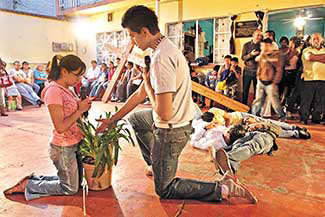
|  |  |  Entertainment | April 2009 Entertainment | April 2009  
Rehearsals for the Largest Holy Week Procession in Mexico are Long, Intense
 Lauren Villagran - The News Lauren Villagran - The News
go to original


| | (The News Photos/Rodrigo Oropeza) |  |
A remembrance of the Passion of Christ - the suffering Jesus faced as he was betrayed, bore his cross and was crucified - has come to life in a Mexico City borough every year during Holy Week for more than a century.

An estimated 2 million people go to Iztapalapa to witness this re-enactment of the Passion of Christ, an 11-kilometer procession repeated on each of four important holy days between April 5 and April 11. The Passion in Iztapalapa is considered the largest in Mexico and one of the largest in the world.

The procession winds through Iztapalapa's original eight barrios - San Ignacio, San Lucas, San Pablo, La Asunción, San José, San Pedro, San Miguel and Santa Barbara - stopping in the chapel of each on Palm Sunday, Holy Thursday and Good Friday. A representation of Jesus' resurrection on Easter Sunday is held a day early, on Saturday.

Iztapalapa's procession is not to be confused with any regular Passion play. All who are native to the borough or have seen Iztapalapa's Passion in action understand the seriousness of the event.

"It's not a show - it's a true representation," said Reymundo Orduña Suárez, who sells socks and rosaries in front of Iztapalapa's central plaza.

"More than a representation, it's been about reliving the Passion," said Father José de Jesús Aguilar, subdirector of radio and television of Mexico City's Catholic Archdiocese.

Three months of rehearsals and more than a century of tradition will culminate in Iztapalapa's 166th representation of the Passion of the Christ this week.

THE EIGHT BARRIOS

Iztapalapa is Mexico City's most populous borough, with some 2 million residents. But only those "who have the blood" of the borough's central eight barrios - born of a division of Iztapalapa's original two indigenous communities, Axomulco and Atlalilco - can act in the Passion.

That is to say: Only if you were born in one of the eight neighborhoods, or you are the child of someone born in one of the eight, may you participate.

Some 2,000 people, generally not actors by trade, act in the procession each year.

Iztapalapa's Holy Week Committee, a community association, holds castings for the most important roles: Jesus, Mary and Judas. Among the other main roles are those of the 12 apostles, the Nazarenes, the virgins and the council that condemns Christ to crucifixion.

For those who take on one of the key personages, the rules are strict and the responsibilities are many.

Those playing Jesus and Mary, for example, are banned from vices including alcohol; they may not have piercings; and Mary, in particular, may not have any romantic commitments - no boyfriends - during the more than three months of rehearsals up through the weeklong performance.

MARY, JESUS AND JUDAS

This year Violeta Calderón Valle, a 21-year-old law student from barrio San Miguel, plays the role of Mary.

"As a little girl, this was a dream I had," she said. "My parents would bring me to the procession. I would say, `When I grow up, I want to play the Virgin Mary.' "

Calderón Valle has long, straight black hair and bright, wide eyes. She says she professes her Catholic faith by going to church every Sunday and confession too. As for the requirements of her part, she says it's not in her plans to have a boyfriend, "because I want to give the best of me and give myself over to the role."

"My life is really tied to the church," she said.

Diego Villagran Villalobos is a strikingly tall 18-year-old who plays American football at his college and will take on the role of Jesus in the Passion. He met the minimum age and, at 6-foot-3, the additional requirement for the play's central role: He is tall enough to be seen above the masses of actors and spectators.

Villagran Villalobos, who is from barrio San Pablo, is finding that he is already recognized in the streets, even before the Passion takes place.

"People see me in the open rehearsals and when they see me in the street, they say `good luck' and `do your best' - you've got the main role."

The villain, Judas Iscariot, is played by Jaime Domínguez Cabello, a 38-year-old husband and father of three from barrio La Asunción.

"I'm excited to participate because I'm from here, because I have the right to do it," he said. "Being the villain, the bad one, the betrayer, it's still part of this representation. It's important to conserve this tradition."

ROOTED IN TRAGEDY

Iztapalapa's Holy Week tradition has its roots in an 1833 epidemic of "cholera morbus" that ravaged the community. There were no death records for Iztapalapa at the time, but deaths registered in Mexico City amounted to 14,000 in just one month, between August and September, that year.

"There was no count in Iztapalapa, but our great-grandfathers said that upon burying one dead person, there would be 20 more to bury the next day," said Anatolio Avila Domínguez, president of the Holy Week Committee.

Devastated by the epidemic, the people of Iztapalapa pleaded to their patron saint, El Señor de la Cuevita (the Lord of the Little Cave), that he might spare them from further tragedy. It is said that on the day they dedicated a Mass to their saint and asked for mercy, there were only five deaths. The second day, three people died and on the third day the deaths stopped.

A promise was made to carry on a Mass in the saint's honor every year, without fail.

Ten years later, in 1843, the thanksgiving tradition grew into a representation of the life, passion and death of Jesus. |

 |
|  |



